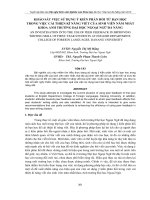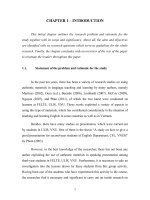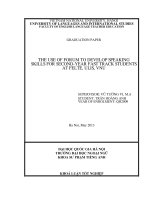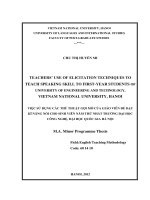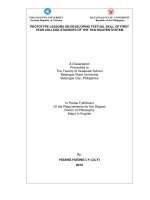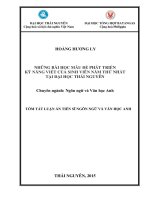Việc sử dụng hồ sơ tập bài để phát triển kĩ năng viết của sinh viên năm thứ nhất tại trường đại học ngoại thương
Bạn đang xem bản rút gọn của tài liệu. Xem và tải ngay bản đầy đủ của tài liệu tại đây (1.88 MB, 66 trang )
VIETNAM NATIONAL UNIVERSITY, HANOI
UNIVERSITY OF LANGUAGES AND INTERNATIONAL STUDIES
FACULTY OF GRADUATE STUDIES
DO THI AN
THE USE OF PORTFOLIOS TO DEVELOP FIRST YEAR
STUDENTS’ WRITING SKILL AT FOREIGN TRADE UNIVERSITY
“VIỆC SỬ DỤNG HỒ SƠ TẬP BÀI ĐỂ PHÁT TRIỂN KĨ NĂNG VIẾT
CỦA SINH VIÊN NĂM NHẤT TẠI TRƯỜNG ĐẠI HỌC NGOẠI
THƯƠNG”
M.A. MINOR THESIS
Field: English Teaching Methodology
Code: 60140111
HA NOI – 2015
VIETNAM NATIONAL UNIVERSITY, HANOI
UNIVERSITY OF LANGUAGES AND INTERNATIONAL STUDIES
FACULTY OF GRADUATE STUDIES
ĐỖ THỊ AN
THE USE OF PORTFOLIOS TO DEVELOP FIRST YEAR STUDENTS’ WRITING
SKILL AT FOREIGN TRADE UNIVERSITY
“VIỆC SỬ DỤNG HỒ SƠ TẬP BÀI ĐỂ PHÁT TRIỂN KĨ NĂNG VIẾT CỦA SINH
VIÊN NĂM NHẤT TẠI TRƯỜNG ĐẠI HỌC NGOẠI THƯƠNG”
M.A. MINOR THESIS
Field: English Teaching Methodology
Code: 60140111
Supervisor: Dr. Nguyễn Đức Hoạt
HÀ NỘI – NĂM 2015
ACCEPTANCE
I hereby state that I, Do Thi An, CH22A, being a candidate for the degree of
Master of Arts accept the requirements of the College relating to the retention and
use of Master’s Graduation Paper deposited in the library.
In terms of these conditions, I agree that the origin of my paper deposited in
the library should be accessible for the purpose of the study and research, in
accordance with the normal conditions established by the librarian for the care, loan
or reproduction of the paper.
Signature
Hanoi - October, 2015
i
ACKNOWLEDGEMENT
This study could not have been completed without the help, encouragement
and support from the people who play indispensable roles and have a great
influence on the research.
First of all, I would like to express my deepest gratitude to Dr.Nguyen Duc
Hoat – a sincere and enthusiastic supervisor, for his careful reading, critical
comments and useful guidance during my research. His contribution played an
integral part in the completion of my study. Thank to his help and his enthusiasm, I
have more inspiration to conquer challenges and complete this research on time.
I wish to thank 40 students from two classes – TAN.101.4 and TAN.101.33 at
Foreign Trade University, Hanoi for their cooperation and willing participation in
finishing my writing course as well as completing my questionnaire.
Last but not least, I am truly grateful to my friends, my colleagues and my
family for their continual encouragements during the time I carried out the research.
ii
ABSTRACT
This study was carried out for two aims – first, to find out the roles of
portfolio in teaching and learning EFL writing and its theoretical bases; second, to
evaluate the effectiveness of portfolio on developing EFL students’ writing skill
and increasing their motivation.
To fulfill the objectives, quasi experimental research was utilized. 40 firstyear students were chosen to take part in the experiment – a writing course. They
also answered questionnaire and completed self assessment. The collected data then
were cautiously analyzed.
The results of this research are, in summary, quite positive. Using portfolio,
as a complementary to traditional tests, in teaching and assessing EFL writing was
recommended and that assessment should be an integral part of the teaching
process. The study concluded that writing portfolio is found to be an effective
instructional strategy to improve students’ writing skill and enhances their English
writing motivation. In addition, portfolio assessment strategy allows students to
create a bridge between their teacher and themselves when students get feedback
from their peer and teacher. Based on the findings of the study, one extremely
important recommendation is that portfolio should be planned and implemented by
EFL teachers in writing classes at Foreign Trade University.
Though the limitations have been unavoidable, the study is expected to be
beneficial to teachers, students and researchers of the related studies.
iii
TABLE OF CONTENTS
ACCEPTANCE .......................................................................................................................................... I
ACKNOWLEDGEMENT ........................................................................................................................ II
ABSTRACT ............................................................................................................................................. III
TABLE OF CONTENTS ......................................................................................................................... IV
LIST OF ABBREVIATIONS ................................................................................................................... V
LIST OF TABLES AND FIGURES ........................................................................................................ VI
PART A: INTRODUCTION .................................................................................................................... 1
1. RATIONALE - STATEMENT OF THE PROBLEM .............................................................................................. 1
2. AIMS OF THE STUDY ................................................................................................................................... 2
3. RESEARCH QUESTIONS ............................................................................................................................... 2
4. SIGNIFICANCE OF THE RESEARCH ............................................................................................................... 3
5. SCOPE OF THE STUDY ................................................................................................................................. 3
6. ORGANIZATION OF THE STUDY ................................................................................................................... 3
PART B: DEVELOPMENT .................................................................................................................... 4
CHAPTER 1: LITERATURE REVIEW ................................................................................................. 4
1.1 KEY CONCEPTS......................................................................................................................................... 4
1.1.1 Writing as aprocess and writing as a product .................................................................................. 4
1.1.2 Portfolio........................................................................................................................................... 4
1.1.3 Portfolio Assessment ...................................................................................................................... 8
1.1.4 Writing skill ................................................................................................................................. 12
1.1.5 Writing performance .................................................................................................................... 13
1.1.6. Motivation .................................................................................................................................... 14
1.2 PREVIOUS RESEARCH ............................................................................................................................. 19
CHAPTER 2: METHODOLOGY ..........................................................................................................23
2.1. RESEARCH DESIGN: QUASI - EXPERIMENTAL ......................................................................................... 23
2.2 SETTING ................................................................................................................................................. 23
2.3. PARTICIPANTS ....................................................................................................................................... 24
2.4 DATA COLLECTION INSTRUMENTS ......................................................................................................... 24
2.5 DATA COLLECTION PROCEDURES ........................................................................................................... 26
2.6. DATA ANALYSIS ................................................................................................................................... 28
CHAPTER 3: FINDINGS AND DISCUSSION .......................................................................................30
PART C: CONCLUSIONS AND RECOMMENDATIONS ...................................................................39
REFERENCES ........................................................................................................................................43
APPENDICES ................................................................................................................................................ I
APPENDIX 1: SELF-REPORTING QUESTIONNAIRE............................................................................................. I
APENDIX 2: SELF-ASSESSMENT .................................................................................................................... III
APPENDIX 3: PORTFOLIO HOLISTIC SCORING RUBRIC ( PHSR) ................................................................... III
APPENDIX 4: SAMPLES OF STUDENTS’ WRITING DRAFTS .............................................................................. VI
iv
LIST OF ABBREVIATIONS
ELT: English language teaching
EFL: English as foreign language
L2: Second language
ESP: English for special purpose
v
LIST OF TABLES AND FIGURES
Tables/Figures
Page
Table 1.1 Traditional assessment vs Portfolio assessment
9
Figure 2.1 Pre-post tests design
24
Figure 2.2 The process of the portfolio-based writing
27
Figure 3.1 Comparison between scores of both group in pre-test
30
Figure 3.2 Comparison between scores of both group in post-test
31
Table 3.1 The average mark of students
31
Figure 3.3 The percentage of students having planning step
34
Figure 3.4 The percentage of students having planning step
34
Figure 3.5 The percentage of students having revising step
34
Figure 3.6 The percentage of students having editing step
34
vi
PART A: INTRODUCTION
1. Rationale - Statement of the Problem
Recently, the use of portfolio has been a topic commonly mentioned in
methodologies which are especially suggested for English writing classes; since
portfolio is not only to document students’ achievements, but also to demonstrate
how their skills have developed over the years as a consequence of their learning
background. According to Yang (2003),“Portfolio is considered as a compilation of
students’ work, which documents their effort, progress and achievement in their
learning, and their reflection on the materials negotiated for the portfolio”.
Obviously, portfolio is considered as an effective method used in language learning
classroom and plays an indispensable part in leading to the success of a lesson.
Nonetheless, they often receive less attention than they should. To save time,
teachers always choose the quickest way to give students tasks and assess their
performance through these single tasks only. This can causes the ineffectiveness in
students’ carrying task process as well as their final result.
In the light of process-based approach, students’ work is evaluated through a
whole process of effort. They step by step improve their writing skill and enhance
the written work quality day after day. Using portfolio is the way fully expressing
the effectiveness of this approach. With portfolio method applied in class,
traditional teaching style in which teachers give one writing task, students make one
daft no longer takes its dominant place in classroom. Instead, students have more
opportunities to complete their writing in a series of many writing versions. They
keep making improvements from their first draft until they satisfy with their final
product. Once they have done their work, they must be more confident with the
significant progress they have made. Hence, they will have a reason for trying next
time and raise more motivation to do their writing task. From this point of view,
besides helping students increase writing ability, using portfolio to motivate
students in writing is essential as well.
1
Turning back to the studying context at Foreign Trade University, in the
writing course, a process-oriented approach to writing instruction is not effectively
supported, and students are usually expected to write their essays in the traditional
one-draft, one-reader context where instructors simply judge students' final
products. Students did not receive any timely or quality feedback throughout the
semester as students' essays were simply scored against the holistic rubrics and
returned. That is the reason why the quality of students’ writing cannot be
guaranteed. Teachers, thus, must think about applying portfolio to increase their
students’ ability and inspire them more in writing activities.
Considering all the ideas above and with the hope to get a profound insight
into the roles of writing portfolio method perceived by first-year students and to
find out the ways this method increase students’ writing ability and motivation, the
researcher has decided to choose the topic “The Use of Portfolios to Develop FirstYear Students’ Writing Skill at Foreign Trade University”
2. Aims of the study
This study aims to:
-
describe portfolio method, its roles in teaching and learning EFL writing and
its theoretical bases;
-
evaluate the effectiveness of portfolio on developing EFL students’ writing
skill and performance and increasing their motivation.
3. Research questions
The study aims at answering the following questions:
To what extent does portfolio improve EFL students’ writing skill and
performance?
How does writing portfolio increase their writing motivation?
2
4. Significance of the research
This study is conducted with the hope that its findings will be beneficial for
teachers of English and for the teaching English process as well. The results of this
study may help teachers aware of the indispensable importance and necessity of
using portfolios. Moreover, this study would be a reliable source of information for
researchers who wish to carry out studies on similar issues in the future.
5. Scope of the study
This study is carried out with the participation of 40 first-year students at
Foreign Trade University. These students, aged 18 to 20, are non-English majors
who are required to take a core foundation writing course as one of compulsory
subject. It will focus on the use of portfolio in writing class to develop students’
writing skill, writing performace and enhance their writing motivation.
6. Organization of the study
This study consists of three main parts:
Part A: Introduction: provides the rationale, the aims, the research questions, the
significance and the scope of the study.
Part B: Development: comprises three chapters:
Chapter 1, which is named “Literature review”, presents some main terminologies
in the research.
Chapter 2 entitled “ Methodology” presents the methodology used in the study. It
includes the description of the participants, the data collection instrument, the data
collection procedures and the data analysis procedures.
Chapter 3, namely “Findings and Discussion”, describes the results of the study
and discussions based on them.
Part C: Conclusion: summaries the findings and give limitations and suggestions.
3
PART B: DEVELOPMENT
CHAPTER 1: LITERATURE REVIEW
This part sheds light on the background and relevant contents of the study. In
the first place, it is necessary to give definition of two concepts – writing process
and writing product. After that, three key concepts including portfolio, writing skill
and students’ motivation, are presented in this section as theoretical fundamentals to
frame the study. Finally, the last content of the literature review concentrates on the
related studies.
1.1 Key concepts
1.1.1 Writing as a process and writing as a product
Writing as a process: Crowhurst (1988) defined the writing process as "the
thinking processes that go on during writing" (cited in Saskatchewan Education,
1998, p. 2).
Kirby (2002) wrote that "the creative writing process permits the author to
construct through a series well planned out stages, a thorough piece of writing that
is both organized in its presentation and thorough in its development " (p. 1).
Seow (2005) sees writing process as "a private activity which comprises four
main stages: planning, drafting, revising, and editing" (p. 315).
In the present study, writing process refers to the four writing stages the students
pass through to produce a text which are planning, drafting, revising, and editing.
Writing as a product: In the current study, this term refers to the final writing
product. It involves certain productive writing skills, which are taken into account
in the assessment of the end product namely, purpose, content, organization,
vocabulary, sentence structure, and mechanics.
1.1.2 Portfolio
1.1.2.1. Definition of Portfolio and Writing Portfolio
4
The term portfolio derives from the Latin verb “portare”, meaning to carry
and the Latin noun “foglio”, meaning sheets or leaves of paper. Barnard & Deyzel
(2003) defined portfolio as “a portable, systematic, purposeful collection of work,
selected to provide information about attitude, level of development and growth
during a given period of time. It is a powerful visual tool that provides evidence of
self-assessment, personal reflections, learning, growth and development and a
comprehensive and complex overview of skills.”
On the other hand, Yang (2003) defined portfolio as “a compilation of
students’ work, which documents their effort, progress and achievement in their
learning, and their reflection on the materials negotiated for the portfolio”. This
study will follow this definition because it is important to take into account the role
of a portfolio in the learning process in order to grow and advance in all skills.
For this study, writing portfolio intends to situate learners in a real-life
circumstance such as writing an article about certain topic in a true setting such as
the classroom and their peers. All those components raise interest through
interrelations among the task, the self, the other, the context, and the use of
language. In consequence, the whole process offers multiple options in the teaching
and learning process. Writing portfolio also leads learners to showcase genuineness
and uniqueness interacting with peers and strengthening social relations, become
agents of their own intellectual growth, be aware of their virtues and shortcomings
through self-reflection, and develop critical thinking through the evaluation of the
issues they are researching and writing about. As Paulson, Paulson, and Meyer
(1991) point out, portfolios provide the students with the opportunity to reflect
about learning, about the meaning of contexts and about themselves as learners.
Additionally, writing portfolio permits both students and teachers to reflect
on strengths, weaknesses, and the learning process (Paulson & Paulson, 1991).
Furthermore, through the implementation of writing portfolio, teachers can
determine students’ abilities, predilections, and learning styles as this way of
teaching is eminently student-centered (Nunes, 2004).
5
This classroom tool has been used from the mid-1980’s as a form of
alternative assessment that accounts for authentic work in the classroom facilitating
teaching and learning; according to White ( 1994, cited in Conard, 2001), “
portfolios bring teaching, learning, and assessment together as muttually supportive
activities, as opposed to the artificialtity of conventional tests” (p. 27). Regarding
the academic benefits, Aydin (2010) points out that "Portfolio keeping in EFL
writing is beneficial to the improvement of vocabulary and grammar, knowledge,
reading, research, and writing skills” (p. 194).
Other characteristics of writing portfolio pertinent to this study highlighted
by Hamp-Lyons and Condon (2000) include: they are accumulations of students’
works rather than single writings, they allow the students to show and develop
different skills, they enable the students to participate in selecting the topics,
discussing and reflecting about content, and evaluating their own and peers’ works;
in addition, the students can see their own progress and learning of language and
contents. The authors claim that a simple collection of students’ writings does not
constitute a real writing portfolio, unless it implies reflection. Such foundations of
writing portfolio have given rise to a task design based on process rather than
product which enables students’ interaction, decision making, and reflective
thinking.
1.1.2.2 Main types of Portfolios
Showcase portfolios
This type of portfolio is a collection of the student best or favorite work
determined through a collaborative student - teacher selection. Only completed
work is included; thus the showcase portfolio emphasizes the products of learning.
In addition, this type of portfolio is especially compatible with audio-visual artifact
development, including photographs, video tapes, and electronic records of students
completed work. The showcase portfolio includes reflections by students on the
decision-making processes used to determine which work is included.
6
Collection portfolio
This type is also known as the 'working portfolio', 'documentation portfolio',
or 'growth portfolio'. This strategy involves a collection of work showing growth or
change over time and reflecting and documenting students' achievements.
Specifically, the collection portfolio includes everything from brainstorming
activities to rough and/or early drafts to finished final drafts of all student work.
The collection can include the best and weakest of students work. It is clear that
such type of portfolio emphasizes the process of learning.
Process - oriented portfolio
The process - oriented portfolio tells the story of a student growth over time.
It documents learning process as well as portfolio development process. The
portfolio includes early rough drafts, reflections on the process, and difficulties
encountered along the way. Additionally, this approach inevitably emphasizes
students' reflection on their learning process, including the use of reflection sheets,
reflective journals, think logs, and related forms of metacognitive processing. It is
necessary to organize the portfolio content in a way that exhibits a student work
from the beginning, middle, and end of a learning period.
Product - oriented portfolio
It is a collection of student best work. The purpose of such collection is to
document and reflect on achievements rather than the processes a student immersed
in to produce them. Students have to collect all their work until the end of a
learning period, at which time they must choose samples that represent their best
work. It is very common for each work sample in a product-oriented portfolio to be
accompanied by self-reflection, usually in writing, on why and in what ways the
samples represent work of high quality.
To sum up, both types of portfolios are used at all grade levels. It is proved;
however, that a process-oriented portfolio is more common at the elementary level
as individual growth is the object of concern rather than determining specific levels
of performances. A product-oriented portfolio, on the other hand, is more common
7
at the secondary level as older students generally have higher thinking skills
necessary to select their best work wisely as well as engage in self-reflection
process deeply (Sweet, 1993; Epstein, 2005).
As a general rule, the purpose of the portfolio determines its type and
consequently its content. However, portfolios typically are developed for one of
three basic purposes: to show growth, to showcase current performance, or to
evaluate an achievement (Mueller, 2006). And as cited in Puhl (1997), Gottliob
(1995) listed six purposes for creating portfolios: collecting, reflecting, assessing,
documenting, thinking, and evaluation. Arter (1995), on the other hand, mentioned
only two purposes for developing portfolios: assessment or instruction. Portfolios
may be used to keep track of what a student knows and can do. They also can be
utilized to promote learning through the process of assembling the portfolio. Thus,
the teacher has first to identify the purposes for creating a portfolio and then
determine the portfolio types that serve the purposes.
1.1.3 Portfolio Assessment
1.1.3.1 Definition of Portfolio Assessment
In fact, portfolio assessment is also one kind of portfolio in general.
However, this important type is analyzed more carefully than the others since it is
closely related to the result of this study.
There are many different definitions of “portfolio assessment”. Moya and
O'Malley (1994) viewed portfolio assessment as "the procedure used to plan,
collect, and analyze the multiple sources of data maintained in the portfolio" (p. 14).
Hancock (1994) referred to portfolio assessment as " ongoing process involving the
student and teacher in selecting samples of student work for inclusion in a
collection, the main purpose of which is to show the student's progress" (p. 4).
Defining the term, Puhl (1997) mentioned that portfolio assessment is "a
meaningful collection of student work to give a fuller picture of what a learner has
8
achieved " (p. 9). According to Sewell, Marczak, &Horn (1999), it is defined as "a
way to examine and measure progress, by documenting the process of learning or
change as it occurs" (p.1). Furthermore, Neiman (1999) defined it as "a selected
collection of work that shows not only the best work, but also the development of
the individual's work over a period of time. An added dimension is the individual's
reflection of his /her development to the present and for the future " (p. 1). Eissa
(2003) defined portfolio assessment as: "The practice of saving lots of things that a
student writes so that the student and his or her teacher can look at the collection
and see how they are doing" (p. 13).
Based on the above definitions, portfolio assessment is operationally defined
in this study as the strategy of keeping a purposeful collection of writing tasks a
student performs during the course of English over a period of time (one term). The
collection shows the different writing stages in the production of a piece of writing
as well as the end product. It includes guidelines for selecting contents of the
portfolio, and assessment criteria by which student performance is judged. The
student's involvement in selecting contents and reflecting on her own works is of
great concern.
Foreign language educators need to able to choose and/or design assessments
that meet their most important instructional and assessment needs and which they
have the resources to implement and evaluate. Below are some strengths of
portfolio assessment, seen in contrast to traditional forms of assessment.
Table 1.1 Traditional assessment vs Portfolio assessment
(Retrieved from />
9
Traditional
Portfolio
Measures student's ability at
Measures student's ability over
one time
time
Done by teacher alone; student Done by teacher and student;
often unaware of criteria
student aware of criteria
Conducted outside instruction Embedded in instruction
Assigns student a grade
Involves student in own
assessment
Does not capture the range of
Captures many facets of
student's language ability
language learning performance
Does not include the teacher's Allows for expression of
knowledge of student as a
teacher's knowledge of student
learner
as learner
Does not give student
Student learns how to take
responsibility
responsibility
1.1.3.2 Steps in the Portfolio Assessment Process
Venn (2000, p. 540) proposed a portfolio assessment model for EFL learners
which included three steps of assessment activities: First, the teacher and the student
need to clearly identify the portfolio contents, which are samples of student work,
reflections, teacher observations, and conference records. Second, the teacher
should develop evaluation procedures for keeping track of the portfolio contents and
for grading the portfolio. Third, the teacher needs a plan for holding portfolio
conferences, which are formal and informal meetings in which students review their
work and discuss their progress. Because they encourage reflective teaching and
learning, these conferences are an essential part of the portfolio assessment process.
Another portfolio model for EFL instruction was suggested by Mueller (2006, p.
10
4) which comprised seven phases. First, identify purpose(s) of the portfolio.
Second, select portfolio audience(s). Third, specify portfolio contents. Fourth,
focus on processes that will be engaged in during the development of the portfolio.
Fifth, manage time and materials in the development of the portfolio. Sixth, share
portfolios with pertinent audiences. Finally, evaluate the portfolio.
This study follows all the steps of the second model introduced by Mueller as it
contained detailed steps and was easy to apply. Nonetheless, at step six which is
“share portfolios with pertinent audiences”, the researcher allowed students to
exchange their writing draft with their friend to get peer-check; and then, after
rewriting, students showed their work to the teacher to get further comments. In
addition, one step was added to this model namely reflection or self - assessment.
With this step, students can develop good reflective skills. They might need to
learn how to respond to questions and/or prompts in a reflection sheet or to any
reflective activity. They also need to learn how to effectively identify strengths and
weaknesses to set goals for themselves, and to develop meaningful strategies for
improvement.
1.1.3.3 Advantages of Portfolio Assessment
Venn (2000) also emphasized advantages of using portfolios in classroom, as listed
bellows:
Promoting student self-evaluation, reflection, and critical thinking.
Measuring performance based on genuine samples of student work.
Providing flexibility in measuring how students accomplish their learning
goals.
Enabling teachers and students to share the responsibility for setting learning
goals and for evaluating progress toward meeting those goals.
Giving students the opportunity to have extensive input into the learning
process.
Facilitating cooperative learning activities, including peer evaluation and
tutoring, cooperative learning groups, and peer conferencing.
11
Providing a process for structuring learning in stages.
Providing opportunities for students and teachers to discuss learning goals
and the progress toward those goals in structured and unstructured
conferences.
Enabling measurement of multiple dimensions of student progress by
including different types of data and materials. (p. 538)
1.1.3.4 Disadvantages of Portfolio Assessment
Requiring extra time to plan an assessment system and conduct the
assessment.
Gathering all of the necessary data and work samples can make portfolios
bulky and difficult to manage.
Developing a systematic and deliberate management system is difficult, but
this step is necessary in order to make portfolios more than a random
collection of student work.
Scoring portfolios involves the extensive use of subjective evaluation
procedures such as rating scales and professional judgment, and this limits
reliability.
Scheduling individual portfolio conferences is difficulty and the length of
each conference may interfere with other instructional activities. (Venn,
2000, p. 538)
1.1.4 Writing skill
Writing skill is one of the four basic skills of language – listening, speaking,
reading and writing. It is a productive skill of language users, which enables them to
put their thoughts into words in a meaningful form and to mentally react to the
message. Though the goal of writing is expression of thoughts and ideas, it is
attained through various phases.
12
Hampton (1989) said that writers are independent when they are able to
write without much assistance. Next, writers gain comprehensibility when they can
write so that it can be read and understood by themselves and others. Then, writers
attain fluency by being able to write smoothly and easily as well as understandably.
Finally, writers gain creativity when they can write their own ideas, not copying
what has already been written, so that they can be read and understood.
The importance of writing skill: Writing skill is an important tool for better
performance in examinations and greater academic achievement. In real life
situation, most potential employers give importance to writing skill. Among a group
of employees requiring writing skill, someone who writes well is sure to stand out
and achieve success more quickly than others. Moreover, it is the writing skill that
has enabled authors to record their thoughts and expressions in books and various
other media from the far past.
Testing writing skill: Two different approaches are used for assessing
learners’ writing ability. Weir (1988) mentioned them as direct method and indirect
method. In the indirect method, writing can be divided into discrete levels:
grammar, vocabulary, spelling and punctuation which can be tested by objective
tests. In the second method “more direct extended” composition tasks can be used
as stimuli for assessing one’s writing capability focusing on an understanding of
vocabulary, structures and cohesive devices. This direct way of testing is regarded
as a suitable tool for assessing the ability to present a written argument in a logical
manner, which cannot be tested in other ways.
1.1.5 Writing performance
According to Longman Dictionary of Language Teaching and Applied
linguistics by Richards, Platt, and Platt (1992), writing performance is “a person's
actual use of linguistics” (p. 269).
Brown (2000) referred to language performance as “the overtly observable and
concrete manifestation or realization of competence. It is the actual doing of
13
something....” (p. 30). Regarding writing performance, he referred to as the actual
production of linguistic events.
Writing performance can also be defined as the act or process of performing
writing tasks (Wehmeier, 2001).
Abu Hjaj (2003) defined it as what students actually do regarding writing tasks
(p.107).
In the present study, it can be defined as the means of scores obtained by the
students in the writing tasks (products) in addition to their scores in the selfreporting questionnaire on English writing processes.
1.1.6. Motivation
1.1.6.1 Motivation in ELT
In spite of all the research and literature on motivation in education, there is
no consensus on a unique definition or orientation. On the one hand, this is due to
the fact that motivation is not a fixed state of mind. On the contrary, it depends on
multiple variables. On the other hand, this is because motivation is a concept that
has undergone fundamental shifts over time and diverse perspectives in the field of
L2 research. Such conceptions have steadily evolved, from Gardner’s social
psychological approach which was a linear cause-effect system in the early sixties
to the current socio-dynamic perspectives, characterized by more complex and
holistic views such as individual differences and the power of context on them.
Ryan and Deci (2000) broadly defined motivation as a force that moves an
individual to do something. Later, Dornyei and Ushioda (2010) point out three
indispensable facts in the term motivation: the “choice” of a particular action or
why students decide to embark on a task or action, the “persistence” with it or why
they spend time persevering with its development, and the “effort” expended on it
or how hard they work to achieve the goals (p. 4). These authors made an overview
of the different periods of EFL research on motivation, the paramount principles of
which are presented here.
14
In the early seventies, social psychologists Wallace Lambert and Robert
Gardner studied how several ethnolinguistic communities in Canada learned
English as a second language as well as the customs, culture, and behavior of those
communities (Gardner, 1985). The key concepts of Gardner’s theory were: the
willingness to acquire the language due to specific interests to make part of a
community, the attitudes towards such learning process in order to identify with
members of that community, and the effort invested to integrate the community by
means of learning the language. Gardner defined motivation as a “combination of
effort plus desire to achieve the goal of learning the language plus favorable
attitudes towards learning the language” (p. 10).
After some critiques of the social psychological period by Crookes and
Schmidt (1991), on the limitation of the motivation concept to the social
psychological field and the unclear borders between attitude toward L2 culture and
motivation, Zoltán Domyei (2005) coined the term “cognitive-situated period” for
the new trend in L2 motivation research. This period met two needs: first, it fused
L2 motivation research with the cognitive revolution; and second, it moved from
ethnolinguistic communities to classroom settings.
The process-oriented period emerged in the late1990’s giving preponderance
to studies undertaken through long periods of time, as a second language
acquisition. Dornyei and Otto (1998) presented a model of the process of L2
motivation with three phases: preactional (wishes and hopes, goals, and intentions);
actional (subtasks, action control, and appraisal of goals achieved); and postactional
(evaluation, elaboration of new standards and strategies, and further planning). This
model, undoubtedly, was more complete albeit still linear in the connection of the
three phases and thereby behaviorist. In addition, the lack of factors such as the self
and the context made this period ephemeral, becoming a transition to a more
complex approach which has been adopted in tins study, the socio-dynamic
perspectives.
The socio-dynamic perspectives of motivation
15
The main contribution of the socio-dynamic perspectives to the field of EFL
motivation research resides in the analysis of the complexity of the diverse
components involved in motivational factors and their interrelations. The most
relevant attribute is the view of motivation from a critical perspective amalgamated
with the individual and the context. Such factors are crucial in the socio cultural
theory. As Dornyei and Ushioda (2010) observe, “Linear approaches to motivation
cannot do full justice to the unique individuality, agency, intentionality and
reflexive capacities of human beings as they engage in the process of language
learning” (p. 76). This socio-dynamic approach was adopted for this study in the
frame of a socio-cultural view of teaching, learning, and research which aims at
analyzing the interactions of students, the group, the teacher, and the task in the
classroom.
1.1.6.2. The importance of motivation
Motivation is very important in language learning and it helps make
learning successful since motivation can influences 3 basic elements, which are why
people decide to do something, how long they want to do it and how hard they are
prepared to work to achieve it (Spratt, M., Pulverness, A., Williams, M., 2005).
According to Ur, P (1996), “Learner motivation makes teaching and learning
immeasurably easier and more pleasant, as well as more productive”. Discussing
about the same topic, Jane (1999) emphasized that motivation is one of the elements
that affect language learning apart from anxiety, inhibition, self- esteem and
learner’s styles. Clearly, motivation expresses its role as a determined element in
the achievement of learning, especially learning a language.
1.1.6.3 Ways to increase motivation of students in class
It will be extremely difficult to point out the ways for an enhancement in
motivation of students without fully understanding about some factors affecting
motivation. Normally, the most common ones which have great influence on
16
motivation are students’ attitudes, personalities, students’ learning styles as well as
learning strategies and teacher’s roles in class. Among these factors, attitude is so
important that it determines the students’ performance in class. If they have a
thought that they are forced to study, they may be not active, not attentive in class
and not willing to join class activities.
From the factors above, many different teaching strategies have been
introduced to increase the learning motivation for students in class. Some main
ways can be listed as following:
A real reflection: to unsure the reality and practicality, teacher should create
learning activities based on topics that are relevant to students’ lives. In other
words, the topics must be meaningful and familiar with students, make them real to
urge students to study about them.
Provision of choice: Providing students with numerous choices is an effective
motivator in which it creates more options for students to choose. Moreover, it gives
students more opportunities to experience.
A balance of challenge: the tasks must have a balance of the level of difficulty. It
means that the tasks should not be too difficult or too easy. The reason is that if the
task is too challenging, students will not be able to deal with the task, so they fail in
completing the task and be easy to lose their motivation. However, if the task is too
easy, students may feel bored because they do not need to invest much effort and
the teacher underestimate their ability. Therefore, the teachers need to balance the
challenge of the tasks.
An establishment of a sense of belonging: “More hands make light work”, people do
best when they are in community with a powerful connection with the world and a
closer relation to other people. Giving students a community sense or a sense of
belonging can help them work more effectively. Thus, group work or a contest,
competition which require students work together can motivate students in learning
more actively, happily and enthusiastically.
17
